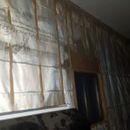Garage condensation advice greatly needed
My attached garage in western SD was constructed with 2×4 walls, 7/16 OSB, tyvek and L.P. Smartside. After thinking insulation was a DIY job, I installed rockwool and covered with 6 mil poly. I plan on hanging 1/2 OSB and painting. The ceiling is sheetrocker, but i haven’t blown fiberglass in the attic yet.
The pic is of the inside of the west wall after a warm sunny day. After much searching, the only consistent info I seem to find is on this site. Would insulating the walls with closed cell spray foam fix this? What about the plastic in the ceiling?
I am now unable to work on this for a couple weeks due to a medical procedure, and am desperate for advice. Thank you.
GBA Detail Library
A collection of one thousand construction details organized by climate and house part










Replies
Ww,
First of all, can you tell us your name? (I'm Martin.)
Just so we can all understand your question: is there condensation on the exterior side of the polyethylene vapor barrier? I'm not quite sure -- the photo isn't clear enough to allow me to be certain of the cause of your desperation.
Is that wall shared with the house? If it’s a shared wall, you have to build it as a fire rated wall, which means 5/8” type X drywall. You can’t leave the poly exposed.
Bill
My name is Wes. The wall with the moisture is not shared with the house. It is the west exterior wall that catches all the sun. Also, the moisture is on the back side of the poly, internal to the stud cavities.
Wes,
Moisture is probably sneaking past the poly because the seams are not airtight. In cold weather, the moisture condenses on the back side of the sheathing, soaking it over time. When the western sun heats up the sheathing, the water evaporates and condenses on the back of the poly, which is now cooler than the sheathing. You've pretty much built your own compact weather system in the walls. Spend some time on this site learning about wall design before going any further.
Wes,
GBA does not recommend the use of interior polyethylene vapor barriers, because there are circumstances when inward drying is useful. In this case, the exterior of your wall assembly appears to be vapor-permeable, moist, and hot, so the direction of vapor drive is inward. The interior of your garage is cool, so the result is predictable.
For more information on this phenomenon, see this article: "When Sunshine Drives Moisture Into Walls."
What you want is an interior material which is airtight but somewhat vapor-permeable. In most cases, GBA recommends the use of drywall covered with vapor-retarder paint. Since this is a garage, what you want is 5/8 inch drywall. Remove the polyethylene and put up the drywall. The drywall should be installed with attention to airtightness.
Hi Wes -
If the situation is solar-driven moisture from the exterior--and I agree with Martin that is likely--than one thing to consider is where is the moisture coming from? Generally, it is the cladding that gets wet, then the sun drives that moisture through the rest of the assembly. Typically, the Class III vapor retarding of the OSB does a decent job of holding the moisture drive off, but not in your case. How wet is this west-facing wall getting?
Peter